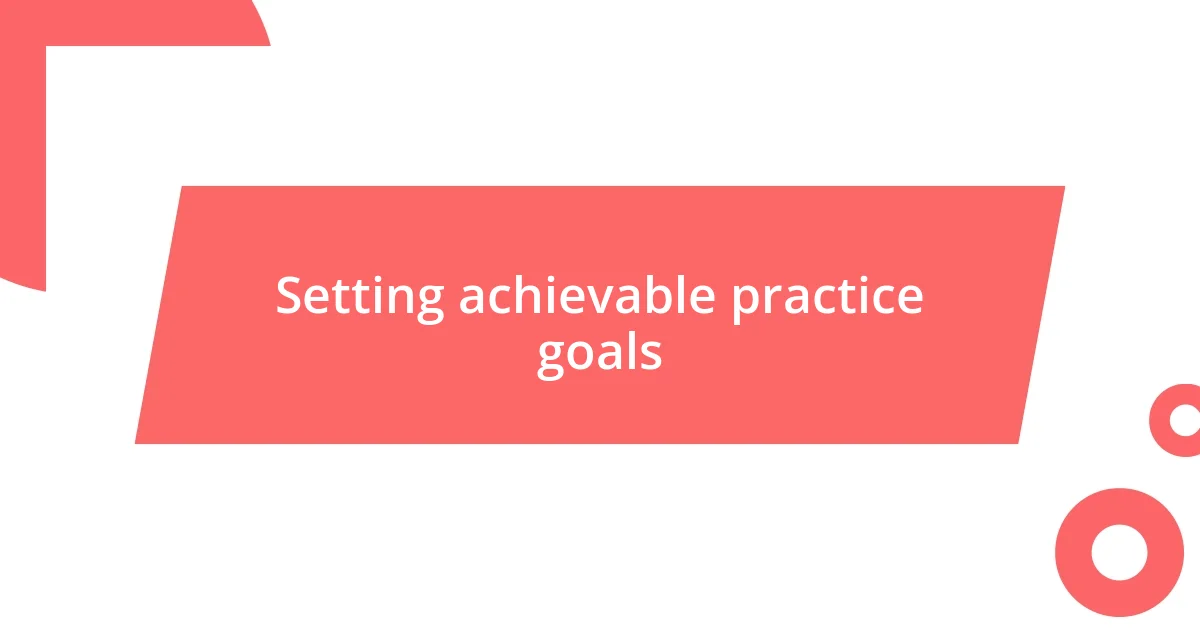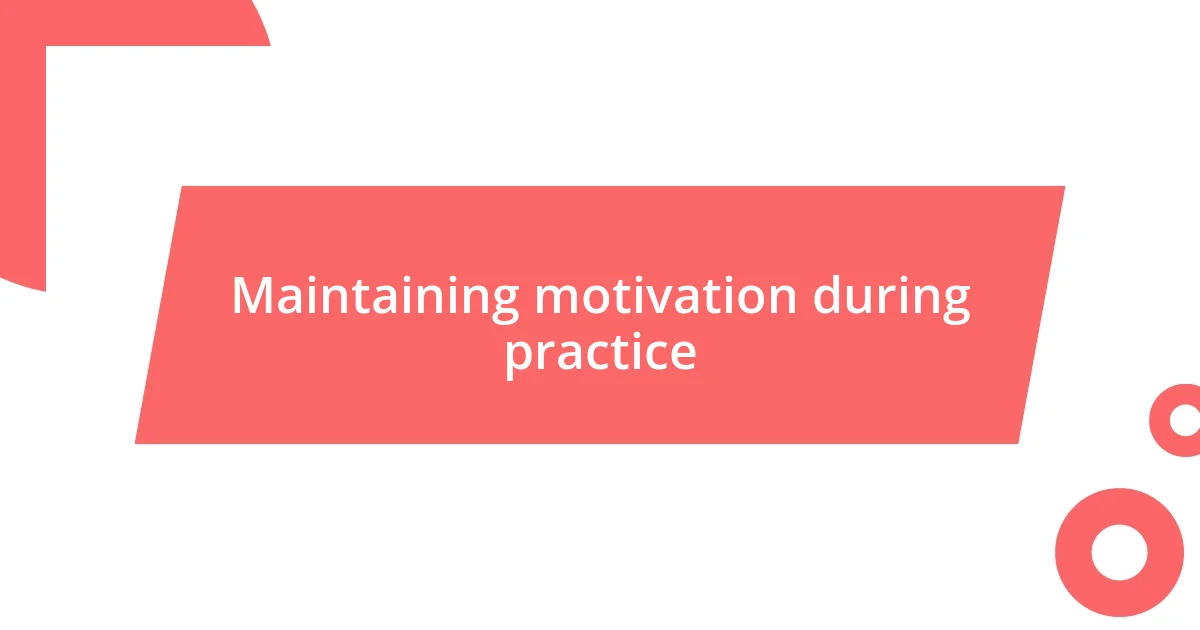Key takeaways:
- Effective practice strategies include focused sessions like the Pomodoro Technique, deliberate practice with specific goals, and varied environments to enhance engagement and creativity.
- Understanding personal learning styles—visual, auditory, and kinesthetic—can significantly improve information retention and engagement in learning processes.
- Maintaining motivation through small, achievable goals, community engagement, and a flexible yet consistent practice routine helps sustain progress and enjoyment in practice.

Understanding effective practice strategies
When I think about effective practice strategies, I often recall those late nights in my room, surrounded by books and notes. I found that breaking my study sessions into focused chunks—like the Pomodoro Technique—helped me stay sharp and engaged. Isn’t it amazing how a simple timer can transform productivity?
Another strategy that really resonated with me was the idea of deliberate practice. Early on, I would mindlessly repeat tasks without much thought, but incorporating specific goals and feedback into my sessions completely changed my results. Have you ever felt stuck in a routine without making real progress? I know I have, and focusing on what to improve each time has been a game changer for me.
Additionally, I’ve learned that mixing up my practice environments keeps the experience fresh and stimulating. For example, switching from a quiet library to a bustling café created a dynamic setting that sparked creativity. It makes me wonder—how often do we limit our own growth by sticking to the same old routines? Exploring new places to practice has opened doors I never anticipated!

Identifying personal learning styles
Identifying personal learning styles can significantly enhance how we absorb and retain information. Personally, I’ve always leaned towards being a visual learner. I remember using colorful charts and diagrams to visualize concepts, which made it easier for me to remember them. Have you ever tried doodling while studying? It might seem counterintuitive, but those little sketches often brought the information to life for me.
Moreover, I discovered that I also possess auditory learning traits. Listening to podcasts or audio recordings of lectures while commuting opened my mind in ways that traditional reading didn’t. The rhythm of spoken words somehow helped me connect the dots more effectively. It’s fascinating how understanding your preferred learning style can make a world of difference in your educational journey.
Lastly, a hands-on approach has proven invaluable as well. I recall my days in a chemistry lab where actually mixing compounds allowed me to grasp complex reactions much better than reading about them in textbooks. Engaging directly with the material provided a tactile experience that solidified my understanding. How do you prefer to engage with new ideas? Reflecting on these methods may unlock a more effective learning path for you.
| Learning Style | Description |
|---|---|
| Visual | Learning through images, charts, and diagrams. |
| Auditory | Learning through listening to lectures and discussions. |
| Kinesthetic | Learning through hands-on experiences and activities. |

Setting achievable practice goals
Setting achievable practice goals is crucial for maintaining motivation and ensuring consistent progress. I vividly remember when I first started learning the guitar. In the beginning, I aimed too high, wanting to master complicated songs right away. It led to frustration and self-doubt. Once I shifted my focus to smaller, specific targets, like learning just a few chords each week, my confidence grew. Do you ever feel that sense of accomplishment when you tick an easy task off your list?
To set achievable practice goals, I recommend the following steps:
- Define what success looks like: Be specific—what do you want to achieve?
- Break it down: Divide your main goal into smaller, manageable tasks.
- Set a timeline: Determine a realistic timeframe for each small goal.
- Keep it flexible: Be open to adjusting your goals based on your progress and feelings.
- Celebrate small wins: Every accomplishment matters—take the time to acknowledge your progress!
In my journey, these strategies not only made the learning process enjoyable but also helped me track how far I’d come, reminding me that each small step counts on the path to mastery. Where do you find joy in your progress?

Evaluating progress and adjusting methods
Regularly evaluating my progress is an essential part of my practice routine. For instance, when I took up painting, I tried to assess my skills after every few sessions by comparing my recent work to earlier pieces. It was surprising to see how much my technique evolved, even with small shifts in focus. Have you ever looked back at your earlier attempts at something and felt a rush of pride? Those moments can be truly motivating.
As I observed my progress, I also learned the importance of adapting my methods to suit my needs. I found that certain techniques worked better for me at specific points in my journey. For example, switching from watercolor to acrylics gave me the freedom to experiment without the fear of mistakes smudging my work. How about you? Have you ever tried something different only to realize it transformed your approach? Flexibility can truly lead to unexpected breakthroughs.
Reflecting on my journey, I noticed that asking for feedback from peers enriched my learning experience. Initially, I was hesitant to share my work, fearing judgment. However, open conversations about my progress illuminated areas for improvement and inspired fresh ideas. Each constructive critique felt like a stepping stone. Have you found that feedback fuels your growth? Embracing it can enhance your practice significantly.

Incorporating feedback for improvement
Incorporating feedback into my practice has had a profound impact on my improvement. I recall a time when I participated in a writing workshop. After sharing my piece, I received constructive comments that challenged my perspective and pushed me to refine my voice. At first, I felt vulnerable—who likes facing criticism? But that moment of stepping out of my comfort zone turned into a crucial catalyst for growth. Have you ever hesitated to ask for others’ opinions for fear of hearing what you don’t want to?
I learned that every piece of feedback is a gift that opens my eyes to new possibilities. There was an instance when a mentor suggested I focus on the emotional depth in my storytelling. Initially, I didn’t see how that would enhance my writing, but as I practiced integrating those suggestions, my narratives became richer and more engaging. It made me think, how often are we blind to the areas in which we could truly shine? Embracing those suggestions helped me connect more deeply with my audience.
Another lesson I’ve taken to heart is the importance of fostering a feedback-friendly environment. In my art classes, we would often share our works in progress and discuss them candidly. It felt amazing to witness others’ vulnerabilities and to witness how we all grew together through our shared experiences. How can we create spaces that encourage honest dialogue? Constructive feedback doesn’t just improve skills; it cultivates community and trust among peers. Through this process, I realized that improvement isn’t a solitary journey but a shared adventure we embark on together.

Maintaining motivation during practice
Maintaining motivation during practice can be a tricky endeavor, but I’ve discovered several strategies that keep my spirits high. For instance, I set small, achievable goals to celebrate along the way. Recently, while learning a new musical piece, I promised myself a little treat for each section I mastered. Each reward, however small, became a delightful reminder of my progress, transforming the process from a chore into a rewarding journey. Do you have similar strategies that help you stay motivated during practice?
Additionally, integrating a routine that includes variety helps combat monotony. When I first started playing the piano, repetition wore me down. So, I began alternating between focused practice sessions and fun improvisation. This blend not only kept my enthusiasm alive but also sparked creativity. Have you ever noticed how quickly different approaches can refresh your perspective? Finding that perfect balance between discipline and play can revitalize your practice.
Finally, connecting with a community can provide that extra boost of motivation. I remember when I joined a local art group; suddenly, I was surrounded by passionate individuals who fueled my drive. Sharing experiences, struggles, and achievements transformed my practice into a shared journey. How has community interaction influenced your own motivation? Surrounding ourselves with like-minded people can be inspiring, bringing a sense of camaraderie that enhances our dedication to improving.

Developing a consistent practice routine
Developing a consistent practice routine has been essential in my journey. I remember when I first started drawing regularly. Setting aside specific times each week to sit with my sketchbook transformed the sporadic doodles into a habit. Do you find that scheduling practice helps you stay on track? For me, it’s almost like creating an appointment with myself; this commitment makes it feel important.
One thing I’ve noticed is that maintaining a consistent practice environment significantly impacts my focus. Early on, I practiced in various places, but it was when I dedicated a corner of my living room for my art that I began to see improvement. There’s something about having a designated space that signals to my brain, “It’s time to create.” How does your environment influence your practice? I believe that a consistent space can inspire discipline and creativity simultaneously.
I also advocate for the idea of mixing things up within a routine. While I stick to my scheduled times, I often change the medium or technique I focus on each week. This keeps things fresh and exciting—like recently, when I spent a week exploring watercolors after a month of charcoal sketches. Sometimes, don’t you need a little shake-up to reignite your passion? Embracing that variety while maintaining my routine has made my practice feel more dynamic and less like a grind.














